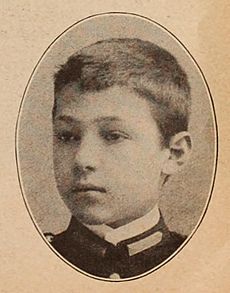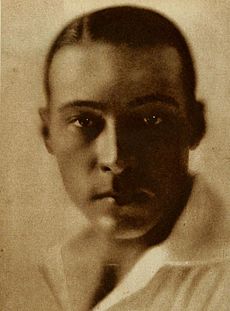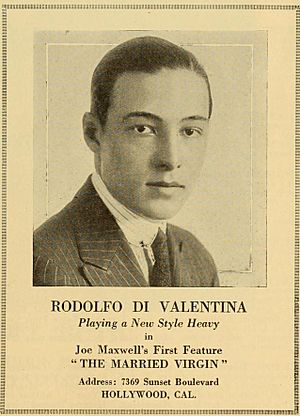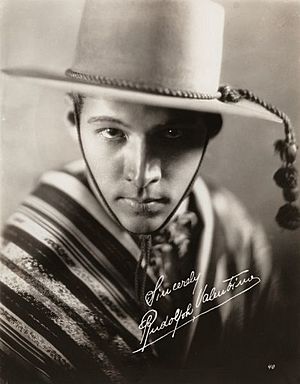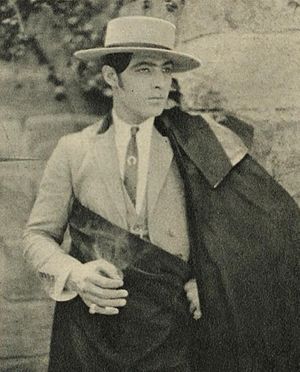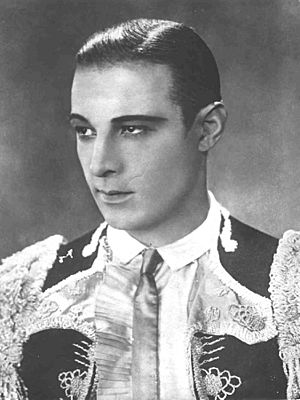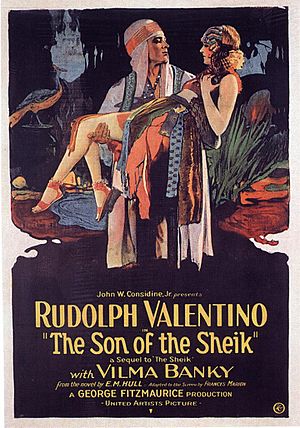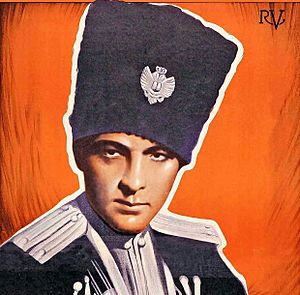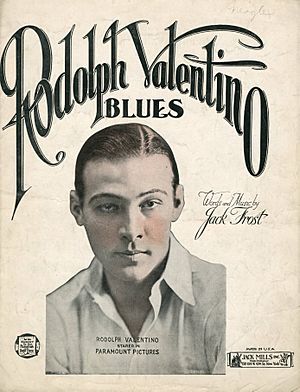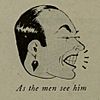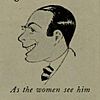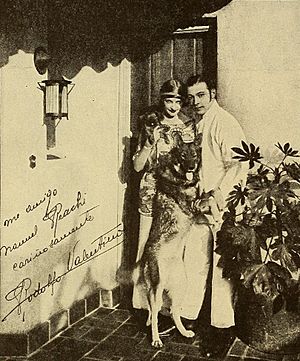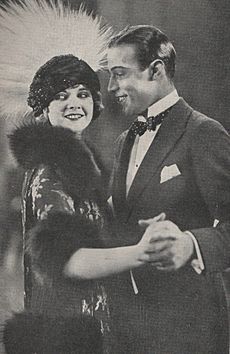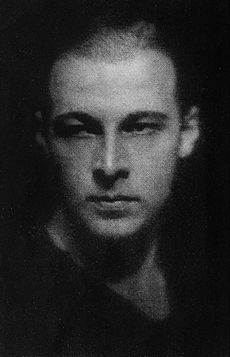Rudolph Valentino facts for kids
Quick facts for kids
Rudolph Valentino
|
|
|---|---|
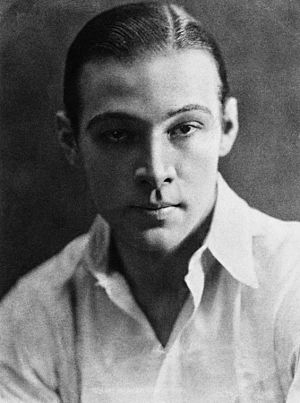
Valentino in 1919
|
|
| Born |
Rodolfo Pietro Filiberto Raffaello Guglielmi di Valentina d'Antonguolla
May 6, 1895 Castellaneta, Italy
|
| Died | August 23, 1926 (aged 31) New York City, U.S.
|
| Burial place | Hollywood Forever Cemetery (Los Angeles, California, U.S.) |
| Occupation | Actor |
| Years active | 1914–1926 |
| Spouse(s) |
Jean Acker
(m. 1919; div. 1923)Natacha Rambova
(m. 1923; div. 1925) |
Rodolfo Pietro Filiberto Raffaello Guglielmi di Valentina d'Antonguolla (May 6, 1895 – August 23, 1926), known as Rudolph Valentino, was a famous Italian actor. He became a big star in the United States during the silent film era. People often called him The Latin Lover.
Valentino starred in many popular movies like The Four Horsemen of the Apocalypse, The Sheik, and The Son of the Sheik. He was a huge icon of the 1920s. When he died at only 31 years old, his fans were incredibly sad. This made him an even bigger cultural film icon in history.
Contents
Early Life and Moving to America
Childhood in Italy
Rudolph Valentino was born in Castellaneta, Italy. His full name was Rodolfo Pietro Filiberto Raffaello Guglielmi di Valentina d'Antonguella. His father was an Italian army captain and veterinarian who died when Rodolfo was 11. His mother was French.
As a child, Rodolfo was very good-looking and playful. He didn't do well in school. He later studied agriculture in Genoa and earned a certificate.
After a short time in Paris in 1912, he went back to Italy. He couldn't find a job there. So, in 1913, he decided to move to the United States. He arrived at Ellis Island when he was 18. Even though he became very famous in America, Valentino never officially became a U.S. citizen. He remained an Italian citizen.
Starting in New York City
When Valentino first arrived in New York City, he worked many small jobs. He was a busboy in restaurants and also did gardening. He even worked as a taxi dancer at a place called Maxim's Restaurant-Cabaret. He danced the tango with people there.
Valentino became friends with a wealthy woman named Blanca de Saulles. When she divorced her husband, Valentino supported her. After the divorce, Valentino faced some legal trouble. The evidence was weak, and he was released from jail.
Because of the public attention from this event, Valentino found it hard to get work. He then joined a traveling musical show. This show eventually took him to the West Coast.
Becoming a Film Star
Before He Was Famous
In 1917, Valentino joined a theater group that traveled to Utah. Later, he joined another show that went to Los Angeles. In San Francisco, he met actor Norman Kerry. Kerry told him to try acting in movies, which were still silent films back then.
Valentino and Kerry moved to Los Angeles and became roommates. Valentino kept dancing and teaching dance. He started to get small roles in films. At first, he often played "heavies" (villains) or gangsters. Most male stars at the time had a "clean-cut" American look. Valentino, with his darker features, became known for playing "exotic" characters.
By 1919, he was getting more small parts. He played a "cabaret parasite" in the movie Eyes of Youth. This role caught the eye of screenwriter June Mathis. She thought he would be perfect for her next big movie.
His Big Break
Valentino was tired of playing villains. He thought about moving back to New York. While filming another movie, he read the book The Four Horsemen of the Apocalypse. He found out that Metro had bought the rights to make it into a movie.
He went to Metro's office in New York. There, he found out that June Mathis had been looking for him! She cast him as Julio Desnoyers. The director, Rex Ingram, and Valentino did not get along well. June Mathis often had to help them work together.
The Four Horsemen of the Apocalypse came out in 1921. It was a huge success with both critics and audiences. It was one of the first films to earn $1,000,000 at the box office. It became one of the highest-grossing silent films ever.
Even after this success, Metro Pictures didn't want to pay Valentino more. They kept his salary at $350 a week. For his next film, they put him in a small part in a low-budget movie. On this film, Valentino met his second wife, Natacha Rambova.
Valentino then worked on the film Camille. He played Armand, the main character's love interest. This film was seen as too unusual by some critics.
Valentino's last film for Metro was The Conquering Power. This movie was also praised by critics and did well. After this, Valentino decided to leave Metro. He wanted better pay and more respect.
The Sheik and More Films
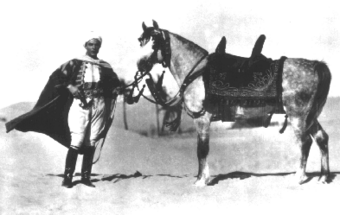
After leaving Metro, Valentino joined Famous Players-Lasky, which is now Paramount Pictures. This studio was known for making more popular, commercial films. June Mathis soon joined him there.
Jesse L. Lasky wanted to use Valentino's star power. He cast him in a role that made him famous as the "Latin lover." In The Sheik (1921), Valentino played Sheik Ahmed Ben Hassan. The movie was a huge hit. It shaped his career and his public image. Valentino tried to show that his character was not a stereotype of an Arab man. He said, "People are not savages because they have dark skins. The Arabian civilization is one of the oldest in the world."
Famous Players made four more films with Valentino. In November 1921, he starred with Gloria Swanson in Beyond the Rocks. This film had amazing sets and costumes. It was thought to be lost for many years. But in 2002, it was found and restored.
In 1922, Valentino started working on Blood and Sand. He played Juan Gallardo, a bullfighter. He was upset that the studio filmed it in Hollywood instead of Spain. He also didn't like some of the production changes.
After finishing the film, Valentino married Natacha Rambova. However, he had not been divorced from his first wife, Jean Acker, for a full year. This was against California law at the time. This led to a public trial. Valentino and Rambova had to get their marriage canceled and stay apart for a year. Despite the trial, the film was a big success. Critics called it a masterpiece. Blood and Sand was one of the top-earning movies of 1922. Valentino thought it was one of his best films.
During his forced separation from Rambova, Valentino filmed The Young Rajah. This movie did not do as well as expected. Valentino felt he didn't perform his best because he missed Rambova. He returned to New York after the film was released. He decided to go on strike against Famous Players.
Striking for Better Pay
Valentino went on strike because he wanted more money. He was earning $1,250 per week. This was much less than other big stars like Mary Pickford. He was also upset because the studio didn't keep its promise to film Blood and Sand in Spain. He wanted to film in Europe so he could see his family. He hadn't seen them in 10 years.
In September 1922, he stopped taking paychecks from Famous Players. The studio then sued him. Valentino did not give up. Famous Players realized they were losing a lot of money. They offered to raise his salary to $7,000 a week. But Valentino refused.
Valentino said that having artistic control over his films was more important than just money. He wrote an open letter to Photoplay magazine. He explained his reasons, but many Americans found it hard to feel sorry for him. Famous Players also made public statements, saying he was difficult to work with.
Other studios wanted to hire him. But Famous Players used a part of his contract to stop him from working for anyone else. Valentino was now in a lot of debt. He appealed the decision. He was still not allowed to act, but he could take other jobs.
The Mineralava Dance Tour
In late 1922, Valentino met George Ullman, who became his manager. Ullman suggested that Valentino promote Mineralava Beauty Clay Company. Valentino had many female fans, so he would be a great spokesperson.
Valentino and Rambova went on a dance tour. They performed in 88 cities across the United States and Canada. The tour was a huge success. Valentino also promoted Mineralava beauty products and judged beauty contests. A young David O. Selznick even filmed one of these contests.
Back to Movies
Valentino returned to acting after getting a new offer. Ritz-Carlton Pictures offered him $7,500 a week and creative control. He would also film in New York. He accepted the offer.
His first film under the new contract was Monsieur Beaucaire. Valentino played the Duke of Chartres. The movie did not do well. Some American audiences thought it made him look "effeminate." Because of this, Rambova was later banned from Valentino's film sets. Valentino made one more movie for Famous Players, A Sainted Devil (1924). This film is now lost. It had great costumes but a weak story. It also ended up being a disappointment.
After his contract with Famous Players ended, Valentino was still obligated to Ritz-Carlton for four films. His next project was The Hooded Falcon. This movie had many problems from the start. The script was rewritten, and a lot of money was spent on costumes and sets. Because of the high spending, Ritz-Carlton ended their deal with Valentino.
Joining United Artists
While filming Monsieur Beaucaire, both Charlie Chaplin and Douglas Fairbanks asked Valentino to join United Artists. Valentino's contract with United Artists gave him $10,000 a week for three movies a year. It also gave him a share of his films' profits. The contract also said that Rambova could not be involved in his film productions or on set. This caused problems in their marriage.
Valentino chose The Eagle as his first United Artists project. His marriage was under strain, and Rambova announced she needed a "marital vacation." During filming, there were rumors of an affair with his co-star Vilma Bánky, but both denied it. The film received good reviews but earned only a moderate amount of money.
Valentino traveled to London and France after the film's release. He spent a lot of money while his divorce was happening. He then made The Son of the Sheik, even though he didn't like his "sheik" image. Filming began in February 1926. Valentino chose the director and worked with Vilma Bánky again. He was sick during production, but he needed the money to pay his debts. The film opened on July 9, 1926, to great excitement. At the premiere, Valentino made up with June Mathis. They hadn't spoken in almost two years.
Public Image and Impact
Valentino was very sensitive about how people saw him. Women loved him and thought he was very romantic.
However, American men were less impressed. Some even walked out of his movies. At the time, the ideal man was like Douglas Fairbanks. Valentino was seen as a threat to the "All-American" man.
In 1926, a newspaper reported that a machine selling face powder for men appeared in a hotel. An editorial blamed Valentino for making American men seem less masculine. This made Valentino very angry. He challenged the writer to a boxing match, but the challenge was not accepted.
Later, Valentino met with journalist H. L. Mencken for advice. Mencken told him to ignore it, but Valentino felt the article was "infamous." A boxing writer named Frank O'Neill offered to fight Valentino instead. Valentino won the match, which took place on a hotel roof.
Heavyweight boxing champion Jack Dempsey, who trained Valentino, said he was "the most virile and masculine of men."
Other Activities
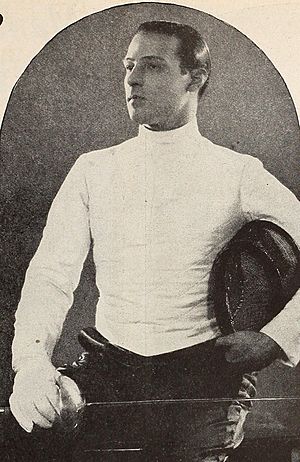
In 1923, Valentino published a book of poetry called Day Dreams. He also wrote articles for magazines about his life. His series "My Life Story" in Photoplay magazine was very popular.
Valentino was interested in all parts of filmmaking. He wanted movies to be more realistic and filmed in real locations. In 1925, he started his own company, Rudolph Valentino Productions.
On May 14, 1923, Valentino made two vocal recordings. He sang "Kashmiri Song" and "El Relicario." These recordings were not released until after his death.
Valentino was one of the first people in Hollywood to create an award for great acting. In 1925, he gave his only Rudolph Valentino Medal to John Barrymore for his performance in Beau Brummel.
Personal Life
Valentino once told a writer that he never found happiness in his love life. He said, "The women I love don't love me. The others don't matter."
In 1919, Valentino quickly married actress Jean Acker. They separated soon after. They remained legally married until 1921, when Acker divorced him. They later became friends again.
Valentino met Natacha Rambova, a costume and set designer, in 1921. They became romantically involved and married on May 13, 1922, in Mexico. However, this led to Valentino's arrest for bigamy. He had not been divorced from Jean Acker for a full year, as required by California law.
They had to get their marriage canceled and live apart for a year. On March 14, 1923, they legally remarried in Indiana.
Many of Valentino's friends did not like Rambova. They thought she was too controlling. During their relationship, he lost many friends and business partners. Near the end of their marriage, Rambova was banned from his film sets by contract. Valentino and Rambova divorced in 1925. Their divorce was difficult. In his will, Valentino left Rambova only one dollar.
Before he died, Valentino was dating a showgirl named Marion Wilson Benda. He was also involved with actress Pola Negri. After his death, Negri claimed they were engaged. However, Valentino had never told anyone this.
Death and Funeral
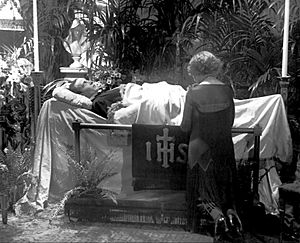
On August 15, 1926, Valentino collapsed in New York City. He was taken to the hospital. Doctors found he had appendicitis and gastric ulcers. He had surgery right away. After surgery, he developed an infection called peritonitis.
His condition worsened on August 21. He developed a severe lung infection called pleuritis. Doctors realized he was going to die, but they didn't tell him. Valentino reportedly believed he would get better. In the early hours of August 23, he talked briefly with his doctors. Soon after, he went into a coma. He died a few hours later at age 31. Doctors later confirmed he had a serious infection called sepsis.
Funeral Services
About 100,000 people lined the streets of Manhattan for his funeral. Windows were broken as fans tried to get inside. A riot broke out, and police had to restore order.
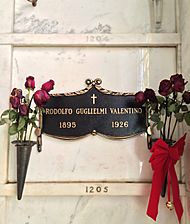
Valentino's funeral mass in Manhattan was held on August 30 at Saint Malachy's Roman Catholic Church. This church is known as "The Actor's Chapel."
After his body was taken by train to California, a second funeral was held. Valentino did not have a burial plot. His friend June Mathis offered a crypt she had bought for her ex-husband. Coincidentally, she died the next year and was buried next to him. Valentino was never moved. They are still buried side by side at Hollywood Forever Cemetery in Hollywood, California.
His Estate
Valentino left his money and property to his brother, sister, and Rambova's aunt. His home in Beverly Hills, Falcon Lair, was later owned by heiress Doris Duke. The main building of the estate was torn down in 2006.
Legacy and Influence
After Valentino's death, many of his films were re-released. This helped pay off his debts. Several books were written about him, including one by Natacha Rambova.
For years, a "woman in black" carrying a red rose has visited Valentino's crypt. This usually happens on the anniversary of his death. It started as a publicity stunt in 1928. But it has become a tradition. The current "woman in black" is film historian Karie Bible. This story inspired the song "Long Black Veil".
Valentino's hometown in Italy, Castellaneta, has honored him. The Museo Rodolfo Valentino opened in his childhood home. A memorial with a blue statue of Valentino was unveiled in 1961. A film school was also opened in his hometown in 2009. From 1972 to 2006, an Italian acting award called The Rudolph Valentino Award was given out.
The type of stomach pain that caused his death is now called Valentino's syndrome. The mascot for Hollywood High School is the Sheiks, named after Valentino's famous character.
The Italian fashion designer Valentino is named after him.
Films About Valentino
The life of Rudolph Valentino has been shown in many films and TV shows.
- Ken Russell's 1977 film Valentino starred Rudolf Nureyev.
- An earlier film, also called Valentino (1951), starred Anthony Dexter.
- In 1975, ABC made the TV movie The Legend of Valentino, with Franco Nero as Valentino.
- Valentino is a character in the TV series American Horror Story: Hotel. He is played by Finn Wittrock. In the show, Valentino fakes his death and becomes a vampire.
- Vladislav Kozlov will play Valentino in the upcoming film Silent Life. Franco Nero will play Valentino's spirit.
Music About Valentino
After his death, many songs were written in tribute to Valentino. Valentino is mentioned in many songs, including:
- "Farewell, Angelina" by Bob Dylan
- "Celluloid Heroes" by The Kinks
- "Manic Monday" by The Bangles
- "Good Old-Fashioned Lover Boy" by Queen
See also
 In Spanish: Rodolfo Valentino para niños
In Spanish: Rodolfo Valentino para niños


